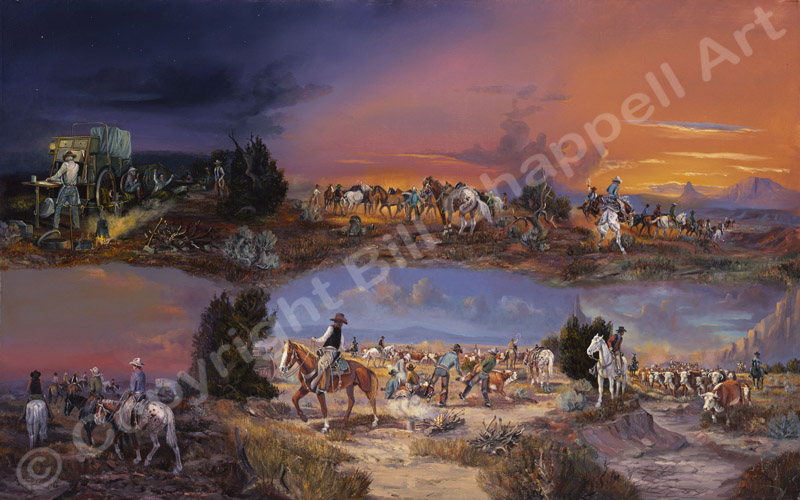Bill Chappell / Art of the West
Reprinted with permission from Wild West Magazine™, August 2009 Edition.

Chappell's "All in a Day's Work" draws on his experience in the saddle.
A cowboy's work is never done. At least, it appears that way in All in a Day's Work, a 30-by-48-inch oil-on-canvas collage of activities that filled a working cowhand's day, from breakfast at the chuck wagon to gathering the horses, riding out to the herd, driving the cattle, branding and returning to camp for supper. Artist Bill Chappell doesn't just depict the working cowboy—he has lived that life. His experience informs his works in various media.
"Back when I was in my teens, I got the privilege of going over to the [more than 500,000-acre] Waggoner Ranch [near Vernon, Texas] and picking up a few strays," he relates during an interview from his gallery and museum on the square in Hamilton, Texas. "I never drew a Waggoner check, but I drew a check from the three little ranches that adjoined Waggoner's. They'd leave the [chuck] wagon out the entire year in those days and put it somewhere pretty close where we were going to work. That's where we did everything. I'd stay over there about 14 to 16 hours."
Born on July 16, 1919, Chappell grew up around cowboys, painting, carving leather, and sculpting clay and wood—and cowboying. He also became "a jackleg rawhide man," repairing saddles with rawhide for west Texas cowboys near Shamrock. "I grew up in the Depression days," he says. "You had no idea you could make a living selling art."
After marrying in 1939, Chappell served in the Navy during World War II, teaching leather crafts at a California base as occupational therapy. When the war ended, he returned to Seymour, Texas, running a saddle and boot shop until 1953. That year he and wife Fay bought a ranch in South Fork, Colo., where they brought up three children.
"We kept expanding and going in debt all the time and working hard and paying for it," he says. Chappell's career got a boost in 1956 when he participated in a Colorado Springs art show, and five of his paintings sold in one night. "This is for me," the aspiring painter told himself. "I'm ready to be an artist."
Initially, he kept his spurs, but then he came to a crossroads. "I had to give up ranching or art, one, and art was paying a lot more than ranching."
Forty years later he hasn't looked back, except for inspiration to create his canvases in watercolor, oil, acrylic, pencil, pen and ink, not to mention works in bronze and silver, including buckles, pistol grips and bolos. The Leanin' Tree Card Company has featured Chappell's work on Christmas and note cards. His work has also appeared at the Leanin' Tree Museum of Western Art, in Boulder; the Buckaroo Hall of Fame Museum, in Winnemucca, Nev; and in several fine art collections.
Health issues have forced him to slow down, but he and Fay still come to the gallery and museum six days a week, greeting visitors, sharing his art and telling stories.
Does he miss his days in the saddle? "I miss it very much," he says. "I got my pelvis broke on a bronc when I was 65 and thought, Well, this might be a good time to sell my horses. It was a privilege that I got to experience those chuck wagon days.
For more information on Bill Chappell see www.historynet.com/magazines/wild_west.